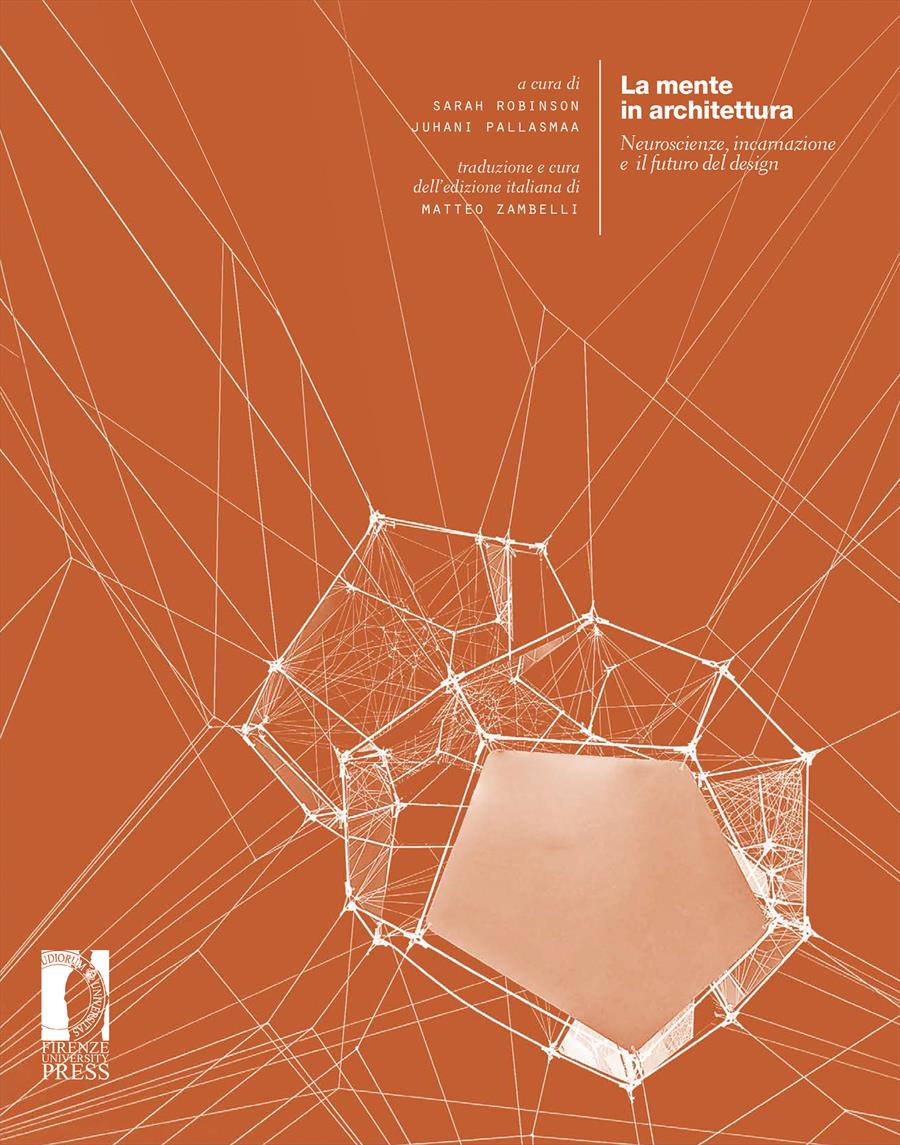- La mente in architettura
- Edited by Sarah Robinson, Juhani Pallasmaa, Matteo Zambelli
Dall’intuizione all’immersione: architettura e neuroscienze
- Melissa Farling
- © 2021 Author(s) |
- CC BY-NC-SA 4.0
- DOI: 10.36253/978-88-5518-286-7.11
Argues that architect’s have a moral imperative to transform and support living conditions and recommends a hippocratic oath for architects to recognise their responsibility to support human wellbeing. A value change needs to shift from considering architecture as an object to architecture as experience and architectural education must take the lead. Discusses the importance of empathy and defining performance outcomes. Suggest ways to apply neuroscientific research at multiple scales
- Keywords:
- Hippocratic oath,
- prison design,
- empathy,
- school design,
- performance outcomes,
Academy of Neuroscience For Architecture, United States
- Academy of Neuroscience for Architecture, visita il sito: http://www.anfarch.org [02/2021]
- Alexander Christopher et al. 1977, A Pattern Language: Towns, Buildings, Construction, Oxford University Press, New York.
- Banasiak M., “Gehry Talks about Architecture and the Mind at Neuroscience Conference”, in «aia News Headlines» [http://www.aia.org/aiarchitect/thisweek06/1110/1110n-gehry.cfm, non più disponibile, n.d.t.]
- Buchanan P. 2011, “The Big Rethink: Towards a Complete Architecture”, in «Architectural Review», 21 dicembre.
- Buchanan P. 2012, “The Big Rethink: The Purposes of Architecture”, in «Architectural Review», 27 marzo.
- Cage Rusty 2003, discorso di apertura all’AIA National Convention del 2003, San Diego, 10 maggio 2003.
- Eberhard J.P. 2006, “You Need to Know What You Don’t Know”, in «AIArchitect», gennaio, p. 1.
- Edelstein Eve, Otto Peter 2012, “Reduction of Medical Error by Design: How the Neuroscience of Hearing Informs Healthcare Design”, presentazione al Salk Institute for Biological Sciences, La Jolla, California, 20 settembre.
- Farbstein Jay, Farling Melissa, Wener Richard E. 2009, Effects of a Simulated Nature View on Cognitive and Psycho-physiological Responses of Correctional Officers in a Jail Intake Area, National Institute of Corrections, Washington D.C..
- Frampton Kenneth 1983, “Towards a Critical Regionalism: Six Points for an Architecture of Resistance”, in Hal Foster, a cura di, The Anti-Aesthetic: Essays on Postmodern Culture, Bay Press, Seattle, Washington, p. 27.
- Heschong Mahone Group 1999, “Daylighting in Schools: An Investigation into the Relationships Between Daylighting and Human Performance”, Pacific Gas and Electric Company, 20 agosto 1999.
- Heschong Mahone Group 2003, “Windows and Classrooms: A Study of Student Performance and the Indoor Environment”, California Energy Commission, ottobre 2003.
- Imirizian Marlene S. 2013, Arizona School Design Primer: The Basic Elements of School Design, Marlene S. Imirizian, Phoenix.
- Lehrer Jonah 2008, Proust era un neuroscienziato, Codice Edizioni, Torino.
- Marco Vitruvio Pollione, De Architectura, Einaudi, Torino, 1997.
- Paul Ricouer 1961, “Universed Civilization and National Cultures”, in Kenneth Frampton, Storia dell’architettura moderna, Zanichelli Editore, Bologna, 1993, p. 371.
- Turner C. 2012, “Brits Declare War on School Curves”, in «Architectural Record», Vol. 200, n. 11, 17 ottobre, p. 25.
- Wener Richard E. 2012, The Environmental Psychology of Prisons and Jails: Creating Humane Spaces in Secure Settings, Cambridge University Press, New York, p. 162.
- Wheeler M. 2010, “UCLA Researchers Make First Direct Recording of Mirror Neurons in Human Brain”, in «UCLA Newsroom», 12 aprile.
Chapter Information
Chapter Title
Dall’intuizione all’immersione: architettura e neuroscienze
Authors
Melissa Farling
Language
Italian
DOI
10.36253/978-88-5518-286-7.11
Peer Reviewed
Publication Year
2021
Copyright Information
© 2021 Author(s)
Content License
Metadata License
Bibliographic Information
Book Title
La mente in architettura
Book Subtitle
Neuroscienze, incarnazione e il futuro del design
Editors
Sarah Robinson, Juhani Pallasmaa, Matteo Zambelli
Peer Reviewed
Number of Pages
240
Publication Year
2021
Copyright Information
© 2021 Firenze University Press
Content License
Metadata License
Publisher Name
Firenze University Press
DOI
10.36253/978-88-5518-286-7
ISBN Print
978-88-5518-285-0
eISBN (pdf)
978-88-5518-286-7
eISBN (xml)
978-88-5518-287-4
Series Title
Ricerche. Architettura, Pianificazione, Paesaggio, Design
Series ISSN
2975-0342
Series E-ISSN
2975-0350
